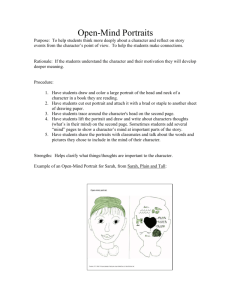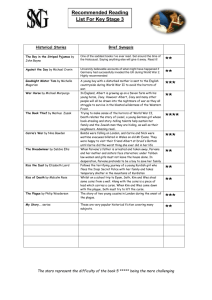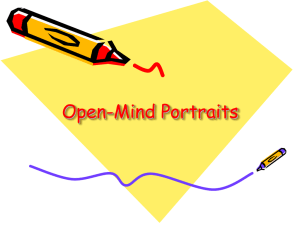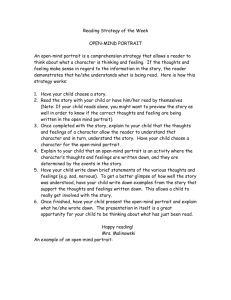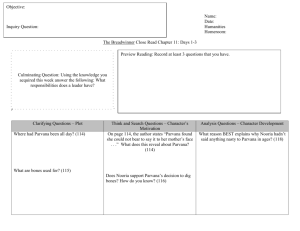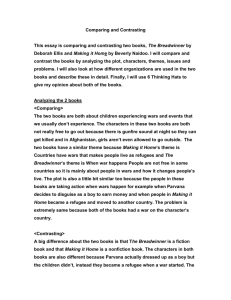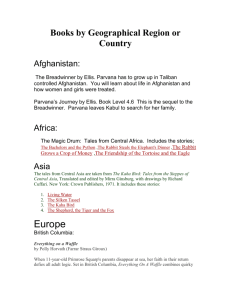Title: Mapping Out Parvana and her Thinking Strategy and Rationale
advertisement
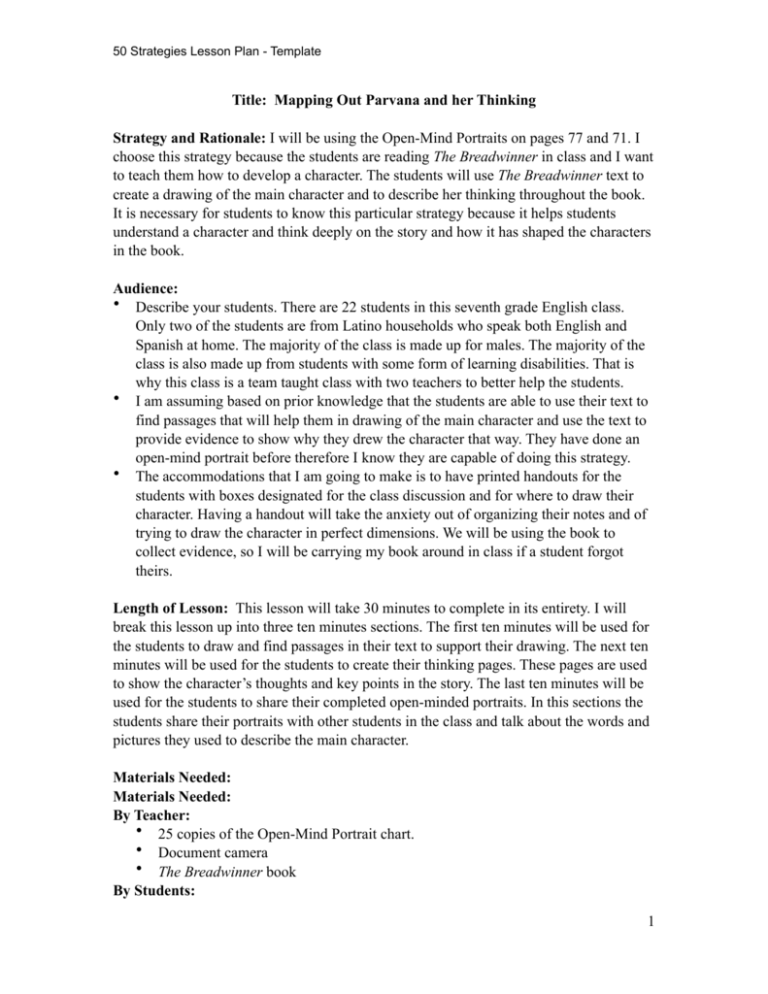
50 Strategies Lesson Plan - Template Title: Mapping Out Parvana and her Thinking ! Strategy and Rationale: I will be using the Open-Mind Portraits on pages 77 and 71. I choose this strategy because the students are reading The Breadwinner in class and I want to teach them how to develop a character. The students will use The Breadwinner text to create a drawing of the main character and to describe her thinking throughout the book. It is necessary for students to know this particular strategy because it helps students understand a character and think deeply on the story and how it has shaped the characters in the book. ! Audience: • Describe your students. There are 22 students in this seventh grade English class. Only two of the students are from Latino households who speak both English and Spanish at home. The majority of the class is made up for males. The majority of the class is also made up from students with some form of learning disabilities. That is why this class is a team taught class with two teachers to better help the students. • I am assuming based on prior knowledge that the students are able to use their text to find passages that will help them in drawing of the main character and use the text to provide evidence to show why they drew the character that way. They have done an open-mind portrait before therefore I know they are capable of doing this strategy. • The accommodations that I am going to make is to have printed handouts for the students with boxes designated for the class discussion and for where to draw their character. Having a handout will take the anxiety out of organizing their notes and of trying to draw the character in perfect dimensions. We will be using the book to collect evidence, so I will be carrying my book around in class if a student forgot theirs. ! Length of Lesson: This lesson will take 30 minutes to complete in its entirety. I will break this lesson up into three ten minutes sections. The first ten minutes will be used for the students to draw and find passages in their text to support their drawing. The next ten minutes will be used for the students to create their thinking pages. These pages are used to show the character’s thoughts and key points in the story. The last ten minutes will be used for the students to share their completed open-minded portraits. In this sections the students share their portraits with other students in the class and talk about the words and pictures they used to describe the main character. ! Materials Needed: Materials Needed: By Teacher: • 25 copies of the Open-Mind Portrait chart. • Document camera • The Breadwinner book By Students: !1 50 Strategies Lesson Plan - Template ! • • • Writing Utensil Handout (Provided by teacher) The Breadwinner Book Lesson Objective: The students will use The Breadwinner text to create an open-mind portrait of the main character and use at least 5 pieces of direct evidence and descriptions from the novel to accurately depict the main character. ! ! Grade Level Content Expectation (GLCE): R.NT.07.01 identify how the tensions among characters, communities, themes, and issues are related to their own experiences in classic, multicultural, and contemporary literature recognized for quality and literary merit. R.NT.07.04 analyze author’s craft including the use of theme, antagonists, protagonists, overstatement, understatement, and exaggeration. R.IT.07.03 explain how authors use writer’s craft and text features including metaphors, similes, captions, diagrams, and appendices to enhance the understanding of central, key, and supporting ideas. R.CM.07.02 retell through concise summarization grade-level narrative and informational text. . ! Assessment: The students will use The Breadwinner text to create an open-mind portrait of the main character and use at least 5 pieces of direct evidence and descriptions from the novel to accurately depict the main character The way I will measure this objective is by making sure the students use direct evidence and description from the book when creating their character portrait. ! ! What is Happening in the Lesson What is Being Said in the Lesson !2 50 Strategies Lesson Plan - Template Classroom Management • I will keep the students in their assigned seats because this activity is meant to be done individually, but if they need help from a neighbor they are close enough to collaborate with them. If the students are talking too much I will simply use the timeout method and then the students know we need to stop talking and refocus on the task ahead. I have chosen to keep the students in their assigned seats so they know this is going to be a lesson the needs individual effort and that everyone needs to participate. • My behavior expectations for the students are going to be the same as every other day of teaching. The students know to be respectful to the teacher when he/she is talking and to raise their hand when they have a question or if the are contributing an answer to a question. . • The students will be instructed to grab the handout before they sit down at their desk. Once all the students have their materials I will instruct them on how to begin their Open-Mind Portrait. ! • Throughout the whole lesson I will make sure to be constantly moving from student to student to make sure they are following along and to check up on their progress. It is important to monitor their progress to make sure they are getting the most out of the lesson and to check myself as a teacher to see what area of the lesson needs to be slowed down or go faster based on (Students walking through the door) Hi good afternoon make sure you pick up the daily handout for today’s lesson. When you have everything please sit at your desk and wait for every one else to get their materials. Me- Does everyone have the Open-Mind Portrait handout? Nate- I don’t have one Mr. Adams. Me- class Where can Nate go to get his handout? Class- Front table! Me- Thank you class. Okay now that everyone has their materials lets get started. ! ! ! • My behavior expectations for the students are going to be the same as every other day of teaching. The students know to be respectful to the teacher when he/she is talking and to raise their hand when they have a question or if the are contributing an answer to a question. The students will work independently as they are drawing and looking through passages in their books to use for their drawing. !3 50 Strategies Lesson Plan - Template Orientation 2 minutes ! I will direct a class discussion about character development. The students have been writing narratives all year so they know how to include characters in their writing and what is needed for character development. I will then tell the students that they will be drawing the main character from The Breadwinner and talk about how she develops as a character throughout the story. The Open-mind Portrait helps students with comprehension of a story by reviewing what major events took place in the story and how that has affected the characters. Me: Alright class today we are going to talk about character development and what makes a good character. I know you have had the opportunities to write narratives in class and had to create your own characters, so what do you think makes up a great character? ! Jason: Characters need a lot of detail. Me: Good, yes characters need detail so the reader can picture them. What else do characters need? ! Ashley: They need to go through a problem don’t they?(Comprehension) Me: That’s great Ashely! Yes characters need to go through a problem or have to face some kind of struggle. Now as a class I want you to talk about what struggles Parvana goes through in the book. ! Me: Walking around, listening to conversations. Nate: Parvana has to help her dad at the market. Joey: Parvana is a girl so she is at risk of being caught by the Taliban. (Application) ! Me: Great discussion. Now that you have remembered some of the struggles Parvana has gone through I want you to draw a portrait of her and her thinking throughout the story. !4 50 Strategies Lesson Plan - Template Making a portait of the character (10 minutes) In this sections the students draw and color a large portrait of the head and neck of the character in a story they’re reading. With the handout that I gave the students they will begin to draw a picture of Parvana by using the text to back up why they gave her the attributes that they did. ! I will give the students ten minutes to draw and indicate what passages of text they are using to draw their character from. If you decide to vary this at all – indicate what steps you are omitting and why you’ve made this choice. Also indicate any steps you’ve inserted and indicate why you made this choice. Teachers vary lesson sequences often – you just need to justify this. ! Describe how the lesson will unfold – what you will be doing. Me: Now everyone should have their open-mind portraits. Correct? ! Class: Yes, Mr.Adams ! Me: Okay, with this handout I want you to draw a portrait of Parvana from the neck up. Hold on hold on hold on! Don’t get started yet. I want you to use your text to find passages that explain why you are drawing her that way. Does anyone have questions? ! Ted: What do you mean by use passages from the text? (Analysis ) ! Me; Great question Ted. I mean that you need to include direct quotes from the book to use as evidence to support your drawing. ! Ted: OHH okay, now I get it. ! Me: anymore questions? ! Jamie: Can we work with a partner? ! Me: I don’t want you to work with a partner because I don’t want you to get ideas from one another. Draw your own picture and use only passages you find and then at the end we will have a class discussion about the passages everyone used. If you have any more questions when you are drawing I will be walking around to help. !5 50 Strategies Lesson Plan - Template Design the “thinking” pages (10 minutes) After the students have completed their portraits of the main character I will then instruct them in creating the “thinking” pages of the character. In this step the students will use additional blanks pages to write and draw about the characters thoughts throughout the story. These pages will show the characters thoughts at key points in the story. I will be walking around to make sure the students are using direct examples from the book during this section. Me: Now that everyone has created their own Parvana I want you now use your additional blank pages and we are going to write or draw Parvana’s thinking throughout key points in the story thus far. This is the point when you really need to include direct quotes from the story as evidence that supports why you drew an image or wrote a sentence to depict Parvana’s thinking. ! Billy: Mr. Adams can we use passages from the beginning of the book? (Comprehension) ! Me: Yes, of course. It would be a good idea to use passages from the beginning up to chapter ten where we just ended. You want to find passages that describe Parvana’s thinking after key points in the book such as when her father was arrested. What were her feelings about it, what might she thought when her dad was being arrested? Think of events like this. Okay? ! Class: Okay! ! Me: Just as before if you have any questions when you are looking for passages or drawing, I will be around to help. I omitted the cut out the portrait and thinking pages because it is wasted time during the exercise. The main thing I want the students to get from this strategy is using their text to provide evidence and to help with their comprehension of the story. !6 50 Strategies Lesson Plan - Template Share the completed open-mind portraits (10 minutes) In this section of the strategy the students share their portraits with classmates and talk about the words and pictures they chose to include on the “thinking” pages. During this time I will first have the students share with their neighbors to get them comfortable with sharing their artwork. As the students are doing this I will be walking around and just observing the students interactions with one another. I want this to be a student led discussion so that they can truly grasp the material. Me: Alright class now we are going to transition into a class discussion. I want you to talk with your neighbor and share your portrait and thinking pages with them. Talk about why you drew something the way you did or why you included a certain passage as evidence for Parvana’s thinking. As you are sharing with one another ask your neighbor questions about their thinking and why it is important to include a characters thinking into a story. As you are doing this I will just be walking around and listening to what you have to say. After the students have been talking with their neighbors about their portraits and “thinking” pages. I will then ask if anyone wants to share something they talked about with their neighbor. I will also ask if they noticed any similarities or differences in their “thinking” pages and what those similarities or differences were. Briefly describe how you will close the lesson. Class: Neighbors sharing their portraits with one another. ! ! ! Me: Okay, who can share something that they talked about with their neighbor? (Synthesis) ! Chelsea: Katie and I talked about how we drew Parvana differently. Katie drew Parvana more as a girl because that’s how she was at home, but I drew her looking more like a boy especially because when she wears a hijab. ! Me: That’s great! Thanks for sharing. Does anyone else want to share what they talked about with their neighbor? ! Chris: Matt and I were talking about our “thinking” pages. I talked about Parvana getting the gifts on her blanket at the market and who she thinks they are coming from. Matt talked about Parvana’s thinking to make money for her family by collecting bones of the dead. ! Me: That’s great! I liked how you two told of specific examples in the text and then elaborated on Parvana’s thinking. !7 50 Strategies Lesson Plan - Template ! !8
